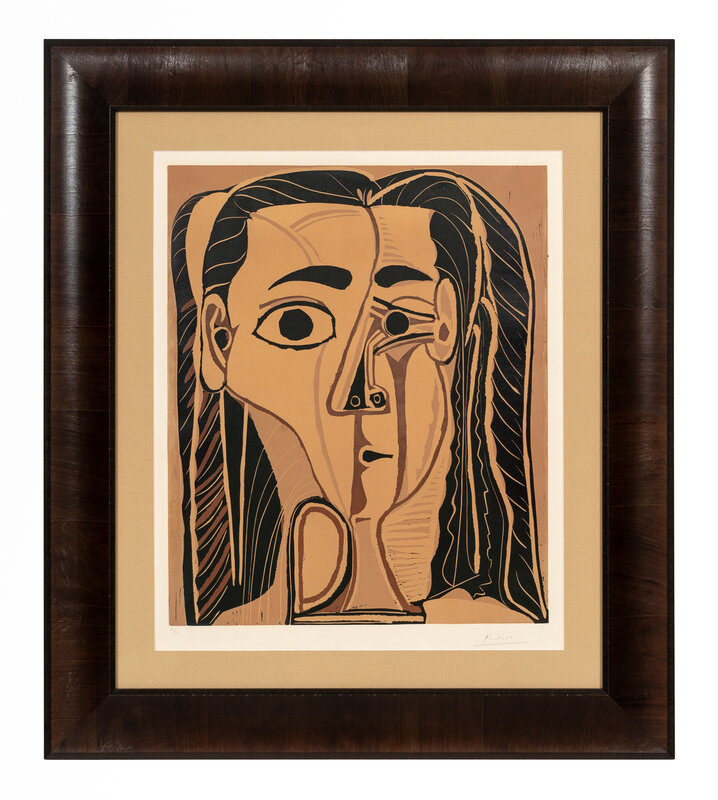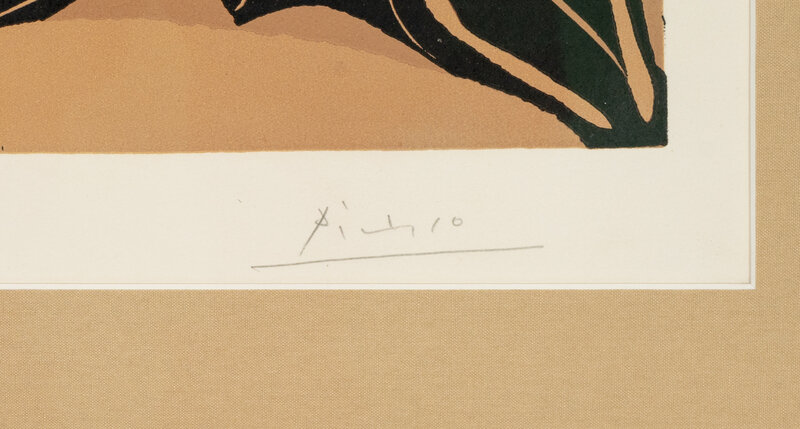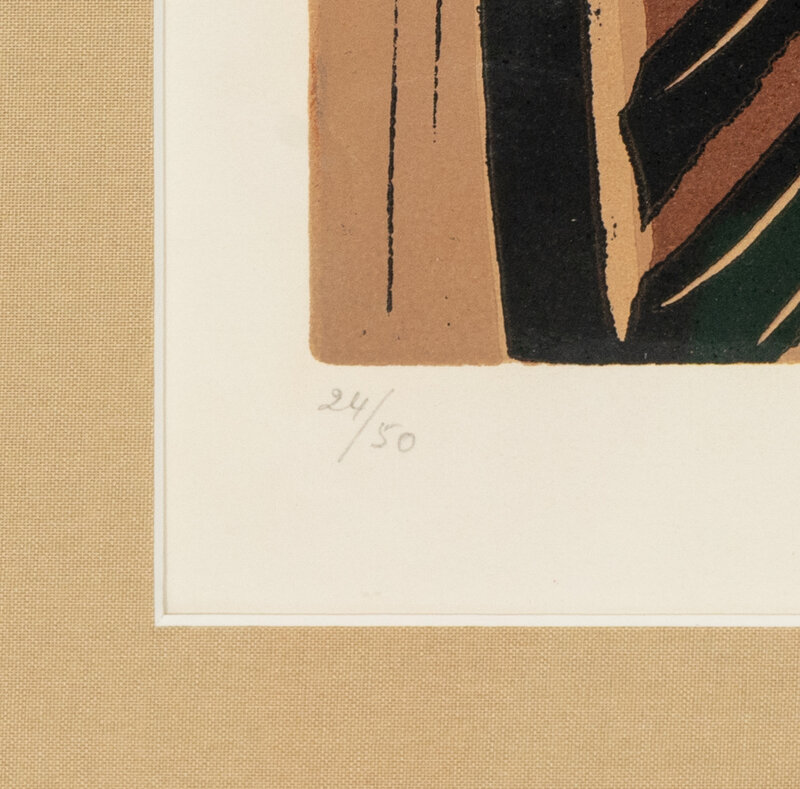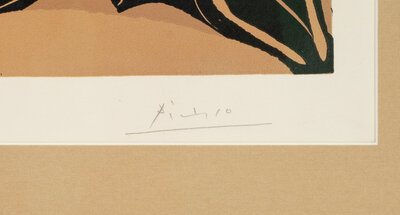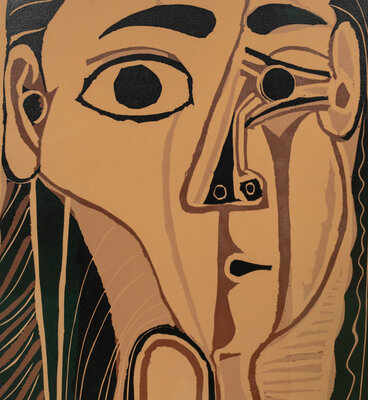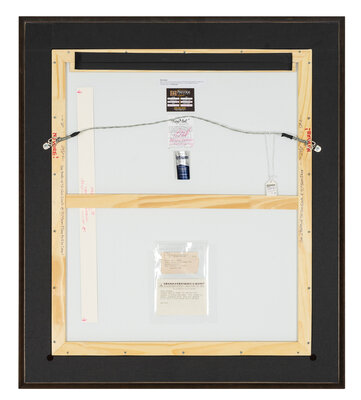Pablo Picasso
(Spanish, 1881–1973)
Jacqueline au Bandeau de Face (Grand Tête de Femme), 1962
Sale 2027 - Picasso: Master of Multiple
Sep 26, 2024
10:00AM CT
Live / Chicago
Own a similar item?
Estimate
$70,000 -
90,000
Price Realized
$88,900
Sold prices are inclusive of Buyer’s Premium
Lot Description
Pablo Picasso
(Spanish, 1881–1973)
Jacqueline au Bandeau de Face (Grand Tête de Femme), 1962
linocut
signed and numbered 24/50 in pencil
25 1/4 x 20 3/4 inches.
Published by Galerie Louise Leiris, Paris; printed by Arnéra, Vallauris
Provenance:
Lillian Heidenberg Gallery, New York
Hokin Gallery, Palm Beach
Literature:
Bloch 1069; Baer 1303
Lot Essay:
Maker and Muse: Picasso’s Jacqueline au Bandeau de Face (Grand Tête de Femme)
By his late 60s, Pablo Picasso was already a highly accomplished artist, yet he remained committed to experimentation and pushing the boundaries of the media with which he worked. In 1947, in Vallauris in the South of France, Picasso began a 24-year partnership with the pottery workshop Madoura to produce ceramics. By the late 1950s, as this collaboration developed and grew, Picasso sought to promote his ceramic work through linocut advertising posters, with the help of local master printer Hidalgo Arnéra. Arnéra and Picasso would collaborate from 1958 to 1963, and, though Picasso, who was then in his late 70s, was well-versed in other printmaking techniques such as etching and lithography, quickly began to explore linocut more seriously.
Picasso reached a breakthrough in the process through his invention of the reductive linocut. Previously, to make a linocut using multiple different colors, a different block of linoleum would need to be cut for each respective color, with the blocks then printed consecutively. However, in Picasso’s method, a single linoleum block is carved and printed, then recarved and printed multiple times in successive stages, with each carved layer corresponding to a different color of ink. Colors are thus printed one on top of the other, starting with the lightest and proceeding to the darkest. The advantage of the technique is that colors line up relatively easily at printing, and the artist does not need to laboriously carve multiple linoleum blocks. The disadvantage is that the artist must be absolutely certain of their next move before carving away more of the block and printing the next color, as this carving cannot be undone.
This sale features three examples of Picasso’s linocuts between 1962 and 1963, at the height of his work with Arnéra. Petit déjeuner sur l'herbe, d'après Manet (The Luncheon on the Grass, after Manet) and L'Homme à la fraise (Man with ruffled collar), Lots 12 and 14, respectively, are both fascinating meditations on past art historical tradition, with the former referencing the notorious scene by Manet and the latter an allusion to Golden Age Spanish portraiture, such as El Greco’s The Nobleman with his Hand on his Chest. However, Lot 15, presented here, Jacqueline au Bandeau de Face (Grand Tête de Femme) (Jacqueline with the Headband), is much more personal to the artist.
Illustrating a woman modeled in flattened blocks of color that echo his earlier Cubist forms, Picasso prominently depicts his second wife and muse, Jacqueline Roque. Roque and Picasso met at Madoura in 1953, where Roque was working. Married in 1955, their relationship was often torrid and controversial, yet nevertheless, Roque was a profound inspiration to Picasso’s work. Characteristic of Roque’s large eyes and dark hair that would become standard in the artist’s portraiture, Jacqueline au Bandeau de Face remains an intriguing example of Picasso’s adaptation and reinvention of the linocut, while also serving as an important marker of this period in his personal life.
Provenance:
Lillian Heidenberg Gallery, New York
Hokin Gallery, Palm Beach
Literature:
Bloch 1069; Baer 1303
Lot Essay:
Maker and Muse: Picasso’s Jacqueline au Bandeau de Face (Grand Tête de Femme)
By his late 60s, Pablo Picasso was already a highly accomplished artist, yet he remained committed to experimentation and pushing the boundaries of the media with which he worked. In 1947, in Vallauris in the South of France, Picasso began a 24-year partnership with the pottery workshop Madoura to produce ceramics. By the late 1950s, as this collaboration developed and grew, Picasso sought to promote his ceramic work through linocut advertising posters, with the help of local master printer Hidalgo Arnéra. Arnéra and Picasso would collaborate from 1958 to 1963, and, though Picasso, who was then in his late 70s, was well-versed in other printmaking techniques such as etching and lithography, quickly began to explore linocut more seriously.
Picasso reached a breakthrough in the process through his invention of the reductive linocut. Previously, to make a linocut using multiple different colors, a different block of linoleum would need to be cut for each respective color, with the blocks then printed consecutively. However, in Picasso’s method, a single linoleum block is carved and printed, then recarved and printed multiple times in successive stages, with each carved layer corresponding to a different color of ink. Colors are thus printed one on top of the other, starting with the lightest and proceeding to the darkest. The advantage of the technique is that colors line up relatively easily at printing, and the artist does not need to laboriously carve multiple linoleum blocks. The disadvantage is that the artist must be absolutely certain of their next move before carving away more of the block and printing the next color, as this carving cannot be undone.
This sale features three examples of Picasso’s linocuts between 1962 and 1963, at the height of his work with Arnéra. Petit déjeuner sur l'herbe, d'après Manet (The Luncheon on the Grass, after Manet) and L'Homme à la fraise (Man with ruffled collar), Lots 12 and 14, respectively, are both fascinating meditations on past art historical tradition, with the former referencing the notorious scene by Manet and the latter an allusion to Golden Age Spanish portraiture, such as El Greco’s The Nobleman with his Hand on his Chest. However, Lot 15, presented here, Jacqueline au Bandeau de Face (Grand Tête de Femme) (Jacqueline with the Headband), is much more personal to the artist.
Illustrating a woman modeled in flattened blocks of color that echo his earlier Cubist forms, Picasso prominently depicts his second wife and muse, Jacqueline Roque. Roque and Picasso met at Madoura in 1953, where Roque was working. Married in 1955, their relationship was often torrid and controversial, yet nevertheless, Roque was a profound inspiration to Picasso’s work. Characteristic of Roque’s large eyes and dark hair that would become standard in the artist’s portraiture, Jacqueline au Bandeau de Face remains an intriguing example of Picasso’s adaptation and reinvention of the linocut, while also serving as an important marker of this period in his personal life.
Condition Report
Auction Specialist

